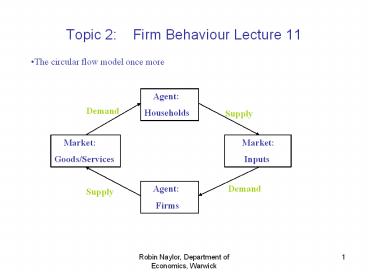Topic 2: Firm Behaviour Lecture 11 - PowerPoint PPT Presentation
1 / 13
Title:
Topic 2: Firm Behaviour Lecture 11
Description:
Topic 2: Firm Behaviour Lecture 11 The circular flow model once more Agent: Households Demand Supply Market: Goods/Services Market: Inputs Agent: Firms – PowerPoint PPT presentation
Number of Views:71
Avg rating:3.0/5.0
Title: Topic 2: Firm Behaviour Lecture 11
1
Topic 2 Firm Behaviour Lecture 11
- The circular flow model once more
Agent Households
Demand
Supply
Market Goods/Services
Market Inputs
Agent Firms
Demand
Supply
2
Topic 2 Lecture 11
Economic Profit, Revenue and Cost Firm
Objective Profit-maximisation Profit Total
Revenue Total Cost (Normal Profit if TR TC
0) Total Cost includes the Opportunity Costs
of the Owner (and hence is one reason for
definitions of costs and profits to vary from the
accountants definition) Lets look first at
Revenues and then at Costs
3
Topic 2 Lecture 11
Revenues The Firms Revenues depend on the
Demand Curve it faces pp(X) e.g. p a
bX Total Revenue is given by TR
p(X)X e.g. TR (a bX)X aX bX2
Now draw the TR curve.
4
Topic 2 Lecture 11
Revenues TR (a bX)X aX bX2
p
X
TR
Now draw the TR curve.
TR
Why does the TR curve rise and then fall . . . ?
X
5
Topic 2 Lecture 11
Revenues TR (a bX)X aX bX2
This has to do with price elasticity of demand .
. .
p
Demand is elastic
Demand is inelastic
D
X
TR
TR
X
Xa/2b
6
Topic 2 Lecture 11
7
Topic 2 Lecture 11
Revenues TR (a bX)X aX bX2
p
Demand is elastic
Demand is inelastic
D
X
TR
MR
MR a 2bX
TR
X
Xa/2b
8
Topic 2 Lecture 11
9
Topic 2 Lecture 11
10
Topic 2 Lecture 11
11
Topic 2 Lecture 11
12
Topic 2 Lecture 11
Revenues
The relationships between Demand TR MR should
all now be clear to you.
p
Demand is elastic
Demand is inelastic
D
X
TR
MR
TR
X
Xa/2b
13
Topic 2 Lecture 11
Now read BB 4th Ed., pp. 444-447 451-452
455 (but dont worry about issues (especially
the mathematical material) which go beyond what
you have seen in lecture notes or seminar
exercise sheets) Note that on these pages, BB
often refer to the firm as a monopolist while
in my lectures I do not use the term monopolist
I simply refer to the firm. Implicitly, Im
talking about a monopoly firm because Im
assuming that there is just one firm in the
market (notice that I never refer to the
existence of competitor firms). A firm is a
monopolist when there are no other firms
supplying output in the market.































